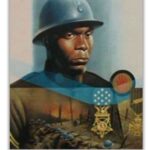
Both soldiers were recommended for a Medal of Honor, but each of those recommendations took an unusual path.
Indeed, a century later, the issue is not completely resolved. Corporal Freddie Stowers finally received his Medal in 1991, but Private Burton Holmes never received one. Efforts to upgrade his Distinguished Service Cross are ongoing.
Stowers and Holmes were both soldiers in the 371st Infantry Regiment, a segregated regiment that served during World War I. “It remained in line for over three months,” historian Emmett J. Scott relates, “holding first the Avocourt and later the Verrières. . . . [The regiment] was then taken out of line and thrown into the great September offensive in the Champagne.”
That great offensive was the known as the Meuse Argonne Offensive, and it was part of the final Allied push to end the war.
On September 28, the 371st attacked Côte 188, a heavily fortified hill in the Champagne Marne Sector of France. Barbed wire ran all around the enemy fortifications, but our soldiers got past the barbed wire and began to close in on the Germans.
Just then, the Germans came out of trenches with their hands in the air. It appeared that they were going to surrender—except then they didn’t. It was a trick! As the Americans came out into the open, the enemy soldiers sprang back into position and opened fire.
The move proved devastating. More than half of the American company was lost within a matter of minutes.
Stowers began crawling forward through enemy fire, leading his squad toward the first enemy trench. “After fierce fighting,” Stowers’s citation describes, “the machine-gun position was destroyed and the enemy soldiers were killed.”
Stowers turned towards the second trench line and encouraged his men to come with him. By this point, he was mortally wounded, but he kept going and kept encouraging his men until he had no more to give. Stowers died before the squad reached the second trench, but his bravery had been enough. His company continued its attack, and Americans would ultimately take the hill.
But what about Holmes? He, too, was present at the attack on Hill 188. He was soon wounded, and his rifle was put out of commission. Nevertheless, he “returned to the company’s headquarters of his own volition,” one of his officers described, “got a reserve automatic rifle, went back and fired with it on the enemy until he was killed. This happened under heavy machine gun and shell fire.”
Remember, Holmes was already wounded. He could have stayed in relative safety, but he chose to return.
Both men were recommended for the Medal of Honor, but Holmes received a Distinguished Service Cross instead. Stowers’s paperwork was lost for decades, but he finally received a Medal in 1991.
There are some who worry that Holmes was awarded a Cross, rather than a Medal, because of the color of his skin. They continue to advocate for Holmes’s Cross to be upgraded to a Medal.
On the other hand, he “was given the Distinguished Service Cross, which they don’t hand out freely then or today,” as noted by Michael Knapp of the American Battle Monuments Commission.
“These guys were victimized, but they were not victims in their minds,” said ABMC’s Gerald Torrence. “That’s why they would step up for something bigger than themselves and put their lives on the line and their blood on the line. They were not victims in their minds.”










Leave a Reply